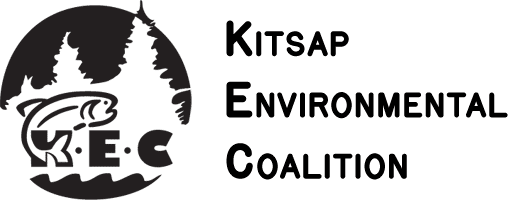COMMENTS FROM THE KEC WORKING COMMITTEE ON THE PROPOSED CAO – continued
3. BUFFER INTEGRITY
We support elimination of the bad buffer bonus in proposed 19.200.220.B by requiring restoration and enhancement of degraded buffers. Amend §B.1 (also suggested above) as follows:
“For degraded buffers, the department must require enhancement or restoration of buffer functionality and/or increase the buffer area or width above the required standard buffer width in Tables 19.200.220(B) through (E). The department shall consult with the Washington Department of Fish and Wildlife and affected Tribe(s).”
And:
“Enhancement or restoration of an existing buffer shall not count as mitigation.”
Best available science and guidance from state agencies (Ecology, WDFW, Commerce) concur that buffers for wetlands, streams, and habitat areas are necessary, multi-functional, of moderate width, and should be undisturbed and well-vegetated. In addition, Ecology stated that buffer widths are considered “moderate”, indicating that widths are not excessive and reductions are undesirable.
Current code §19.300.315.A.1 requires that “Buffers shall remain undisturbed natural vegetation areas except where the buffer can be enhanced to improve its functional attributes.”
Furthermore, DCD Decisions have also included the above code as a Condition that “Permit application approval is subject to chapter 19.200.215 and 19.300.315 of the Kitsap County Code, which states that buffers or setbacks shall remain undisturbed natural vegetation areas except where the buffer can be enhanced to improve its functional attributes. Refuse shall not be placed in buffers.
Despite these clear code items, buffer integrity has been compromised by DCD practices, which have allowed use of buffers for development activities. These activities include clearing, excavation, grading, and placement of permanent compacted fill. Staff have stated that such work is acceptable as long as the area is restored by planting. DCD apparently has mis-read the code phrase “except where the buffer can be enhanced” to mean that a buffer can be disturbed provided the area is replanted. In doing so, DCD turns the plain text of the code on its head. The intent of the ordinance and the specific requirement for buffers to “remain undisturbed” are being ignored.
A more complete definition of “buffer” is required, including a list of ecological functions by which buffers (1) protect functions and values of critical areas and (2) independently provide ecological functions.
There is no scientific basis for decreasing buffers. Because buffers widths are moderate to inadequate, decreases in buffer width or area will generally decrease the ecological functions and reduce the protective benefit for critical areas. We therefore support only a Type III variance process for reducing buffers.
Whereas ‘hand-waving’ in wetland reports has been observed in place of actual analysis of “great or greater” or “no net loss”, it is important that the burden of proof be placed upon the applicant.
Although mention is made of wildlife corridors in both 19.200 and 19.300, we believe that the County rarely considers them at both large and small spatial scales. For example, where erosion can cause soil to flow from a development, silt fencing is often used to protect critical areas. However, the County must not authorize the use of silt fencing without techniques that allow crossing by small wildlife, including amphibians and reptiles. Silt fencing can harm wildlife in and moving in and out of critical areas.
The wildlife corridor width of 100 feet in 19.200.220.C.6.a.i lacks scientific support and is far too small. One hundred meters would be more appropriate for deer or amphibians. Wildlife corridor width should be analyzed with respect to disturbance distances (e.g. Hennings, 2017).
Recommendations.
Revise the definition for buffer 19.150.170:
“Buffer” includes riparian areas and means a well-vegetated area that is intended to protect the functions and values of critical areas. Buffers also provide their own ecological functions. Protecting functions and values of critical areas requires identifying, retaining, and protecting the ecological functions of buffers. These include, but are not limited to, wildlife habitat including use areas, connectivity, and food resources; erosion prevention; passive runoff and stormwater control via slowing, micro-detention, absorption, and infiltration; removal of sediment, nutrients, and toxics; improvement of water quality via biofiltration by fungal, bacterial, and plant communities in the upper soil horizons; maintenance of wetland hydrology and plant communities; increased residence time of water in the subsurface, minimization of peak stream flows, reduction of stream temperatures, and maintenance of seasonal low flows; and groundwater infiltration, both deep and near-surface. Protecting functions and values includes the preservation of existing native and nonnative vegetation, except where a degraded buffer is enhanced or restored.”
Insert new §D.1 under 19.200.220.D:
“Buffers. Buffers shall remain undisturbed natural vegetation areas. Buffers shall be maintained along the perimeter of wetlands. Refuse, fill, yard-waste or other debris shall not be placed in buffers. No clearing, excavation, grading, filling, staging, storage, or other development activities shall occur in buffers. Degraded buffers may be enhanced to improve functional attributes according to a restoration plan.”
Revise 19.300.305.D to read:
“Avoid or minimize human and wildlife conflicts by identifying, preserving, and/or restoring wildlife corridors.”
“Delete existing text and insert the following for 19.300.315.A.1:
“Buffers. Buffers shall remain undisturbed natural vegetation areas. Buffers shall be maintained along the perimeter of streams and habitat areas Refuse, fill, yard-waste or other debris shall not be placed in buffers. No clearing, excavation, grading, filling, staging, storage, or other development activities shall occur in buffers. Degraded buffers may be enhanced to improve functional attributes according to a restoration plan.”
In the introductory paragraph for 19.300.315.A.6, delete “Refuse shall not be placed in buffers.” due to redundancy with §A.1.
Do not use Type I or Type II process, but require Type III for any buffer decrease.
Amend 19.200.220.C.2.b, 19.200.220.3.c, 19.300.315.A.4.b.iv, & 19.300.315.A.4.c.iv by appending “The applicant shall demonstrate that no net loss of ecological functions will occur.” to the currently proposed text.
Amend 19.200.220.C.6 & 19.300.305 to require use of Best Management Practices that are not harmful to small animals.
Amend 19.200.220.C.6.a.i to require a 300-foot wide corridor.
Insert a definition for ‘wildlife corridor.’

